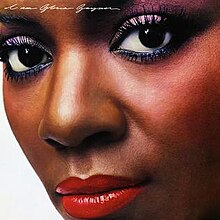| This article needs additional citations for verification. Please help improve this article by adding citations to reliable sources. Unsourced material may be challenged and removed. Find sources: "I Am Gloria Gaynor" – news · newspapers · books · scholar · JSTOR (January 2017) (Learn how and when to remove this message) |
| I Am Gloria Gaynor | ||||
|---|---|---|---|---|
 | ||||
| Studio album by Gloria Gaynor | ||||
| Released | January 20, 1984 | |||
| Recorded | 1982–1983 | |||
| Genre | Pop, disco, R&B | |||
| Length | 32:03 | |||
| Label | Silver Blue | |||
| Producer | Joel Diamond | |||
| Gloria Gaynor chronology | ||||
| ||||
| Review scores | |
|---|---|
| Source | Rating |
| The Encyclopedia of Popular Music | |
I Am Gloria Gaynor is the eleventh studio album by Gloria Gaynor, released in 1984 by Chrysalis Records. The most notable song on the album was Gloria Gaynor's cover of "I Am What I Am" from the musical La Cage Aux Folles. It reached #82 on the Billboard Hot R&B/Hip-Hop Songs charts.
I Am Gloria Gaynor was released under the title "I Am What I Am" on CD in 1996 by Hot Productions, and included two bonus cuts from her 1978 Gloria Gaynor's Park Avenue Sound album ("After The Lovin'/Sweet Sounds For My Baby" and "You're All I Need To Get By") as track 9 and 10 respectively.
Track listing
- "I Am What I Am" (Jerry Herman)
- "Chain of Whispers" (Mike Shepstone, Peter Dibbens)
- "Strive" (Julius Joseph Davis, Linwood M. Simon)
- "Eeny Meeny Macker Rack" (Miriam Stockley, Philip Lane, Stephen Idemark)
- "Bullseye" (Elaine Lifton, Gloria Nissenson)
- "Only In a Love Song" (Albert Pantino)
- "I've Been Watching You" (Galen Underwood, Ken Krasner)
- "More Than Enough" (Gaynor, Joel Diamond)
References
- Colin Larkin (2006). "Gaynor, Gloria". The Encyclopedia of Popular Music. Vol. 3 (4th ed.). Muze, Oxford University Press. p. 705. ISBN 978-0-19-531373-4.
External links
| Gloria Gaynor | |
|---|---|
| Studio albums | |
| Singles | |
| Related articles | |
This 1980s R&B/soul album-related article is a stub. You can help Misplaced Pages by expanding it. |
This 1980s pop album–related article is a stub. You can help Misplaced Pages by expanding it. |